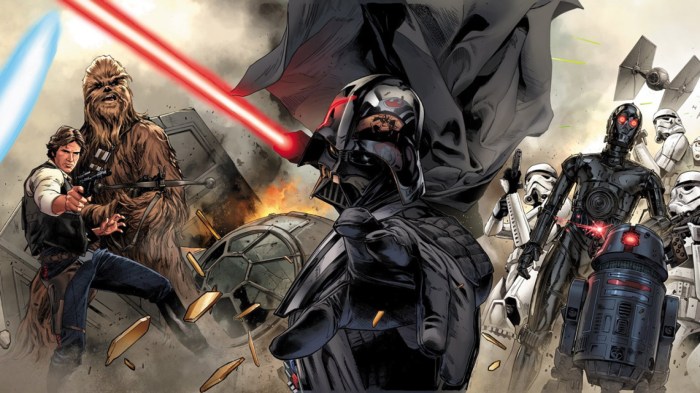
And in the time of greatest despair, there shall come a savior, and he shall be known as: The Son of Suns.”
-Journal of the Whills 3:127
Taken from an abandoned first draft of the screenplay for the original Star Wars, the contents of this prophesy have gripped the fascination of the fandom for generations. While most interest centers around the sobriquet “Son of Suns,” it was the phrase “time of greatest despair” which echoed through my mind while reading the penultimate chapter of Vader Down. In the final version of the first film, the same sentiment is expressed in Obi-Wan’s line “Before the Dark Times; before the Empire,” but the superlative of the earlier drafts communicates the notion more mythically.
So too did another quote come to mind:
[Eucatastrophe] is the mark of a good fairy-story, of the higher or more complete kind, that however wild its events, however fantastic or terrible the adventures, it can give to a child or a man that hears it, when the ‘turn’ comes, a catch of the breath, a beat and lifting of the heart, near to (or indeed accompanied by) tears, as keen as that given by any form of literary art, and having a particular quality.
-J.R.R. Tolkien, On Fairy-Stories
Star Wars #14 is in no way eucatastrophic. We leave Luke unconscious, being carried off by Stormtroopers. Chewbacca too is knocked out, and Han well on his way, being strangled by the powerful paws of a Wookiee warrior, as sizable a sasquatch as ever there was. But such constitutes the wild events, the fantastic and terrible adventures which necessarily preamble the coming climatic eucatastrophe next issue. Without such tremendous trepidation, the requisite relief would hardly prove such a providence.
This of course is the pattern for almost all stories. In any given six issue arc, the fifth chapter will always be the most dire for the protagonists. But the fact that such is formulaic fails to convey just how well writer Jason Aaron executes on such here. His pacing is impeccable, it’s nearest comparison elsewhere in the Star Wars Saga being the Battle of Endor, with Han and the Rebels captured by the Imperial legion, the Alliance’s capitol ships being ripped apart by the shielded Death Star’s superlaser, and Dark Side lightning coursing through Luke’s contorting corpse.
Mike Deodato Jr. delivers his best work on the series to date, even managing to engender excitement into Vader’s saber battle with the utterly ridiculous Commander Karbin. The real highlight, however, is his illustrations of Chewbacca’s brutal brawl with Black Krrsantan, the Wookiee-on-Wookiee violence visceral beyond expectations even.
If there’s one criticism that might be leveled at Deodato, which most fans would not levy, nor am I even sure I’d charge him with such, it’s that the characters are too realistic, too faithful to their appearances on film. I first encountered Deodato’s work in the pages of Thunderbolts and Dark Avengers, where his superhero stylings depicted bulging biceps, powerful pectorals, ripped abdomens, and massive mammaries. In adaptations of comics to cinema, such idealized figures are usually incarnated by actors and actresses of ordinary fitness. Should not the opposite prove true in translating photograpgy to pencils? Deodato’s skill for rendering better bodies than real humans have should not go unutilized here.
Star Wars #14 lacks the levity and charm of Aaron and Deodato’s previous outing, but the dearth of humor is absolutely appropriate to achieving the dyscatastrophic cliffhanger going in to the climatic chapter. Here is their Empire Strikes Back ending, the sour note to sweeten the sure to come success. After all, what is the time of greatest despair if not the darkness just before the dawn?
8.25/10


